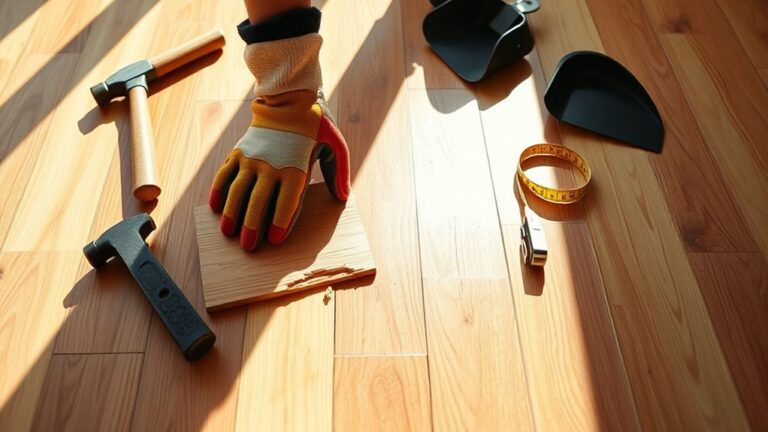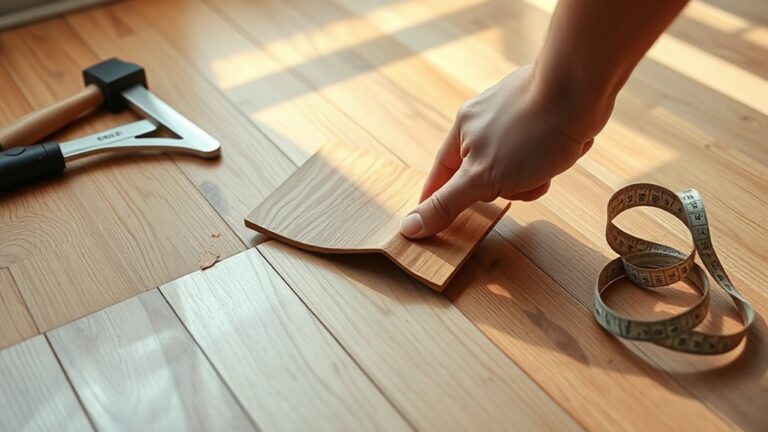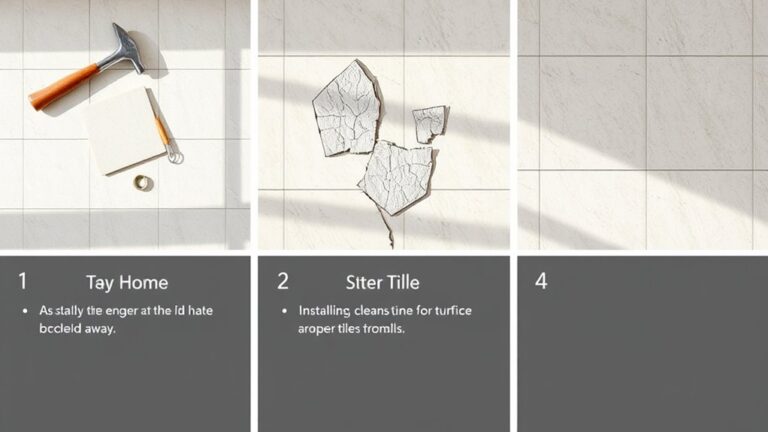To keep your floors in top shape, you'll want to deep clean based on traffic. High-traffic areas like kitchens and entranceways need a monthly deep clean. Moderately used spaces, like hallways, can be done every few months. If you have carpets, aim for a deep clean once or twice a year, or every 3-4 months for high-traffic spots. Hard floors should get a thorough clean at least twice a year, but every three months for busy areas. Don't overlook pets or children; they may require more frequent cleaning. There's much more to evaluate for different floor types and situations.
Importance of Deep Cleaning Floors
Deep cleaning floors is essential for maintaining a healthy indoor environment. You might not realize it, but your floors can trap dirt, allergens, and bacteria, all of which can greatly impact the air quality in your space. By committing to regular deep cleaning, you effectively eliminate these harmful particles, creating a healthier indoor environment for you and anyone else who shares your space.
Neglecting to deep clean can lead to the accumulation of grime and stains, which not only detracts from the aesthetics of your home or office but also shortens the lifespan of your flooring materials. Whether you have carpets, tiles, or hardwood, each type has its own requirements for deep cleaning frequency. For instance, carpets typically need a thorough cleaning at least once or twice a year, while hard surfaces may benefit from quarterly or annual cleanings.
When you prioritize deep cleaning, you're not just improving air quality; you're also minimizing the risk of respiratory issues that can arise from dust and allergens. A clean floor enhances the overall atmosphere of your living or working space, making it more inviting for both occupants and visitors. So, don't underestimate the importance of deep cleaning your floors. Regular maintenance not only promotes a visually appealing environment but also fosters a place where health thrives. Embrace the freedom that comes with a clean, safe, and welcoming space.
Recommended Deep Cleaning Frequency
Establishing a recommended deep cleaning frequency for your floors is vital in maintaining their appearance and longevity. For high-traffic areas, such as entranceways and kitchens, you should aim for a deep clean every month. Frequent cleaning in these spaces prevents dirt buildup and enhances hygiene, creating a welcoming environment.
Moderately high-traffic areas, like hallways and meeting rooms, benefit from deep cleaning every few months. This guarantees that they remain presentable and sanitary, especially in commercial settings where impressions matter. If you're managing a seasonal business, consider scheduling a thorough deep clean before peak seasons to attract and retain customers.
For carpeted areas, deep cleaning is typically recommended once or twice a year. This frequency helps remove embedded dirt, stains, and bacteria, prolonging the life of your carpets. If you find hard-to-reach areas accumulating dust and grime, don't neglect them. A detailed cleaning service can help guarantee these spots are addressed, maintaining the overall cleanliness of your space.
Ultimately, determining the right deep cleaning frequency depends on your specific needs. By sticking to these guidelines, you can effectively manage your environment and enhance the longevity of your floors. Remember, a proactive approach not only improves aesthetics but also contributes to a healthier atmosphere. So, assess your space and implement a cleaning schedule that works best for you.
Deep Cleaning for Hard Floors
When it comes to hard floors, understanding the recommended cleaning frequency is vital for their upkeep. You should aim to deep clean your hard surfaces at least twice a year, with high-traffic areas requiring more attention every three months. Employing essential cleaning techniques, like steam cleaning for tile and grout, will not only enhance cleanliness but also prolong the life of your floors.
Recommended Deep Cleaning Frequency
Maintaining the luster of your hard floors requires a strategic approach to deep cleaning frequency. Ideally, you should deep clean your floors at least once or twice a year to remove accumulated dirt and maintain their appearance. However, some areas need to be deep cleaned more frequently. For instance, high-traffic zones like entryways and kitchens often need a thorough cleaning every three to six months due to increased wear and staining.
Seasonal changes also play a significant role—spring and fall are prime times to address the dirt brought in from outdoor activities. If you have pets or children, consider deep cleaning every two to three months to manage allergens and spills effectively. Regular maintenance, such as sweeping and mopping, is essential between deep cleanings to prolong the life of your hard floor surfaces.
| Frequency | Recommendation | Areas to Focus On |
|---|---|---|
| Every 2-3 Months | Homes with pets/children | Living rooms, play areas |
| Every 3-6 Months | High-traffic areas | Entryways, kitchens |
| At least Once a Year | General maintenance | Whole home |
Essential Cleaning Techniques
To effectively deep clean hard floors, employing the right techniques is essential for maintaining their integrity and appearance. Start by evaluating your flooring type and choosing a pH-neutral cleaner. This prevents damage while effectively removing dirt and grime. Use a damp mop for application, ensuring you don't oversaturate the surface, which can lead to warping or mold.
For added sanitation, consider using a steam mop. This tool can eliminate germs without harsh chemicals, making it a great choice for homes with children or pets. If your hard floors include tile, pay particular attention to the grout lines. A mixture of baking soda and vinegar can work wonders; scrub these areas with a brush to restore their original look.
Regular maintenance is vital. Sweep or vacuum regularly to minimize dirt and debris buildup, making deep cleaning more effective when it's time to tackle it—every 6 to 12 months, depending on traffic levels. By following these cleaning techniques, you'll keep your hard floors looking their best while extending their lifespan.
Deep Cleaning for Carpets
When it comes to deep cleaning your carpets, it's essential to establish a regular schedule, ideally once or twice a year, with high-traffic areas needing attention every 3 to 4 months. You have various cleaning techniques at your disposal, such as steam cleaning or hot water extraction, which can tackle tough stains and odors effectively. By prioritizing deep cleaning, you not only improve the appearance of your carpets but also enhance your indoor air quality and extend their lifespan.
Frequency Recommendations
Carpet care is essential for both aesthetics and health, and understanding the frequency of deep cleaning can greatly impact your home's environment. Ideally, you should deep clean your carpets at least once a year to eliminate trapped dirt, allergens, and bacteria. However, if you have high-traffic areas like hallways or living rooms, consider deep cleaning every 3 to 4 months. This will help maintain their appearance and hygiene, preventing the buildup of grime.
If your home is shared with pets or young children, you might find that dirt and allergens accumulate more rapidly, necessitating more frequent deep cleaning. Seasonal changes also play a role; spring and fall are particularly good times to tackle accumulated dirt and allergens. These periods allow you to refresh your carpets after periods of indoor activity or outdoor debris.
For effective results, professional carpet cleaning services often utilize steam cleaning or hot water extraction methods, which not only provide a thorough clean but also help prolong the lifespan of your carpets. By following these frequency recommendations, you can create a cleaner, healthier environment for you and your family.
Cleaning Techniques Options
Numerous cleaning techniques can effectively deep clean carpets, each offering unique benefits depending on your specific needs and circumstances. For most households, it's recommended to deep clean carpets at least once or twice a year. However, if you have high-traffic areas like hallways and living rooms, consider deep cleaning every 3-4 months to maintain their appearance and hygiene.
One of the most effective methods is professional carpet cleaning, which often utilizes steam cleaning or hot water extraction. These techniques penetrate deep into the carpet fibers, removing dirt, allergens, and bacteria that regular vacuuming misses. While spot cleaning spills immediately is vital to prevent stains, periodic deep cleaning remains essential for overall carpet health.
If you prefer a DIY approach, using specialized equipment like high-efficiency carpet cleaners can also enhance your results. These machines are designed to effectively tackle stubborn dirt and prolong the life of your carpets. Regardless of the technique you choose, remember that regular deep cleaning not only improves the look of your carpets but also contributes to a healthier living environment.
Factors Affecting Cleaning Frequency
Cleaning frequency for floors hinges on several key factors that can greatly influence how often deep cleaning is necessary. Understanding these variables can help you maintain a clean environment, whether in households or commercial spaces. Here are four significant factors to take into account:
- Foot Traffic: High-traffic areas, like retail stores, typically require deep cleaning every few months, while offices may only need it annually. The more foot traffic, the more dirt and debris accumulate.
- Presence of Children and Pets: Households with children and pets often find themselves facing increased cleaning demands. The need to manage allergens and keep floors free of dirt means you might need to deep clean more frequently.
- Seasonal Changes: Seasonal shifts can influence cleaning frequency as well. For instance, spring and fall bring increased pet shedding, leading to a greater need for deep cleaning to maintain hygiene and cleanliness.
- Size and Layout of the Space: Larger or multi-floor facilities usually require more frequent deep cleaning compared to smaller, single-floor spaces. The layout can also affect how dirt and debris are distributed throughout the area.
Benefits of Regular Deep Cleaning
Understanding the factors that influence how often you should deep clean your floors naturally leads to recognizing the numerous benefits of maintaining a regular cleaning schedule. Regular deep cleaning helps remove dirt, allergens, and bacteria that accumulate over time, considerably improving your indoor air quality. Cleaner air contributes to a healthier living environment, making it easier for you to breathe and feel comfortable in your home.
By ensuring your floors are cleaned at least once every few months, you can enhance the longevity and appearance of hardwood and tile surfaces. Deep cleaning prevents damage caused by dirt and grime buildup, which can lead to costly repairs or replacements down the line. For carpeted areas, deep cleaning removes trapped dirt and stains, extending the life of your carpet and keeping it looking fresh and inviting.
Additionally, establishing a routine for regular deep cleaning can reduce the amount of potential food sources and hiding spots for pests, minimizing the risk of infestations. This proactive approach not only protects your home but also contributes to a more pleasant atmosphere.
Tips for Effective Deep Cleaning
Effective deep cleaning requires a strategic approach to confirm you're tackling every corner of your floors. To make certain your space is thoroughly cleaned, it's crucial to follow these tips:
- Start with Vacuuming or Sweeping: Always begin by removing loose dirt and debris. This step enhances the effectiveness of your deep cleaning efforts.
- Use the Right Tools: For carpets, consider a steam cleaner or hot water extraction method, which should be done at least once or twice a year. For hardwood or laminate, a specialized wood cleaner is a must—avoid excess water to maintain their appearance.
- Deep Clean Tile and Grout: Use a mixture of baking soda and vinegar or a commercial grout cleaner. This should be done every 6 to 12 months to remove stains and prevent mold growth in those areas often overlooked.
- Regularly Inspect Floor Mats and Rugs: These can trap dirt and moisture, so deep cleaning them every 3 to 6 months is recommended based on foot traffic.
Frequently Asked Questions
How Often Should I Deep Clean Floors?
You should deep clean your floors based on their types and your lifestyle. For hard surfaces, consider monthly cleanings to tackle dirt buildup, especially in high-traffic areas. Carpeted floors benefit from deep cleaning once or twice a year. Utilize appropriate cleaning methods for each material. Seasonal schedules can help maintain cleanliness and hygiene. Remember to incorporate maintenance tips like regular vacuuming to extend the time between deep cleanings.
What Is the Correct Order in Cleaning Floors?
Cleaning floors is like painting a masterpiece; you've got to follow the right strokes. Start with dusting and sweeping to gather the loose dirt, then mop your hard surfaces with appropriate cleaning supplies. For carpets, vacuum first, then tackle stains. Always follow a methodical approach, moving from the farthest corner to the entrance. Time management is key; schedule regular maintenance to keep your floors looking pristine and to extend their lifespan.
How Often Should Deep Cleaning Be Done Home?
You should aim for deep cleaning your home at least once a year, but if you've got pets or kids, consider every six months. The cleaning frequency may vary based on floor materials; for example, hardwood might need different deep cleaning techniques compared to tile. Regular deep cleaning not only enhances home maintenance but also offers significant health benefits by reducing allergens and improving air quality. Stay proactive for a healthier living environment!
How Often Should I Clean Different Parts of My House?
Have you ever wondered how a well-structured cleaning schedule could change your home? Start by evaluating room priorities based on your family's routines. For high-traffic areas, like kitchens and bathrooms, plan more frequent cleanings. Different surface types require tailored approaches; carpets may need seasonal deep cleans, while hard floors can often wait longer. By aligning your tasks with the seasons, you'll create a harmonious balance, making cleaning feel less like a chore and more like freedom.




